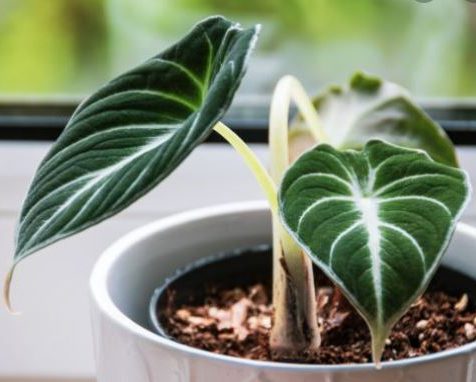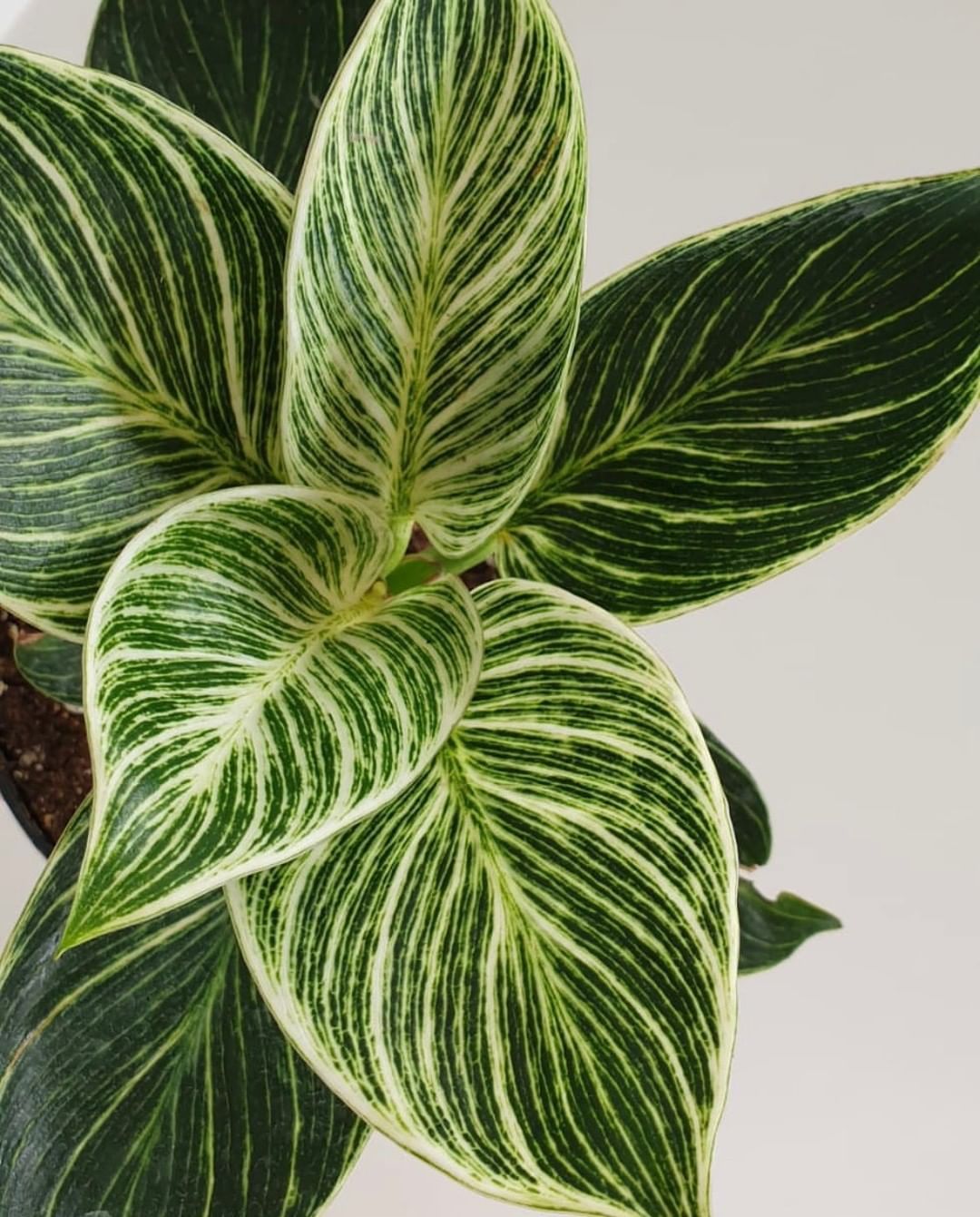An unusual variety that develops pure white stripes on its foliage, becoming more variegated as the plant matures. As a fairly new hybrid for modern cultivation, “Birkin” often shows very interesting variations from leaf to leaf — it is not uncommon to notice occasional bursts of pink or light red on the new leaves as they unfold. A must-have for any collector of rare aroids or lover of variegated plants. Philodendron Birkin belongs to the shrub species.
A slow-growing plant, suitable for growing in small pots. Homeland: the tropics of America. Ideal for landscaping offices and creating live compositions.
Philodendron Birkin Origin and Distribution
The first Philodendrons were discovered back in the 1600s. Ever since then, plant enthusiasts have discovered many other species, hundreds even, and added them to the collection. Heinrich Wilhelm Schott named the collection Philodendron, meaning “tree hugger” in Greek.
Philodendron Birkin plants are commonly found in America and the West Indies. Here, they grow in tropical and subtropical areas, preferring warmth, shade, and lots of humidity.
Philodendron Birkin Care
Lighting Philodendron Birkin
The vast majority of Philodendron Birkin require bright but diffused light during daylight hours. This is especially true for varieties with the variegated colors of the leaf plates. In low light, they will begin to stretch, the leaves will become smaller and lose their bright color. Therefore, if you put a flowerpot with a flower near the lighted window in the openwork shade, you will not lose. It is in such places that the Philodendrons reveal their beauty completely. Direct rays of the sun can spoil the appearance of the leaves, so it is better to completely exclude them from getting on the plant.

Temperature Philodendron Birkin
The air temperature in the room during the spring-summer period should be very high — not lower than 23-28 ° C. If the temperature rises higher, make sure that the watering of the flower is plentiful, and the humidity in the room is higher. Otherwise, the flower will lose its decorative effect from the heat. In winter, in a room with a flower, the temperature should not fall below 16 °C. It is better if it is 18-22 ° C.
At any time of the year, the plant does not tolerate sharp temperature changes.
Do not place a pot with a flower near heating devices, air conditioners or windows during the ventilation of the room – the Philodendron also does not like drafts. Ignoring this rule will lead to the fact that the leaves on the flower will grow unevenly – then small, then larger. The same thing will happen with the growth of the entire plant.
The temperature of the soil should be the same as that of the air, even slightly higher. On cold windowsills, it is better not to keep the flower. If there is no other place, then put a thick stand made of wood or foam under the pan of the pot and separate it from the cold glass with heat-insulating material.
Humidity Philodendron Birkin
The soil in the Philodendron Birkin pot should always be slightly moist, that is, moisture should always be present at the roots, but not stagnate there. The stable, constant humidity of the substrate is a guarantee that the flower will feel good.

With the drought, the leaves will wither and fall off, and with excessive watering, they will turn yellow.
In the warm season, the Philodendron Birkin plant is sprayed with water every 2 days. The leaves of the plant can also be wiped with a soft sponge soaked in warm water.
I water the Philodendron Birkin plant a little 1 time in 2 days.
I do not allow the soil to dry completely, but I also do not allow excessive humidity.
Philodendron Birkin Soil and Pot
You can successfully use ready-made substrates for decorative deciduous crops, with the addition of charcoal and pieces of moss-sphagnum. The main thing is that the soil for Felodendron is light, loose, moisture-and air-permeable, but, at the same time, nutritious, with a slightly acidic or neutral pH.
Another good option for a soil mixture for Philodendron is a ready-made substrate for Orchids. You only need to add a mixture of humus (1h), turf (3h), peat (1h) and sand (0.5 h).
The volume of the pot should be such that the root system is located freely and does not bend. Its size increases by 15-20% with each transplant.
It should have good air exchange, drainage properties, be loose and fertile.

At the bottom of the container for planting, a drainage layer is filled in, and then a fertile, loose, with good air exchange, soil that has a neutral or slightly acidic reaction. It is best to buy a ready-made substrate, but you can prepare the mixture yourself:
- 2 parts of peat;
- 2 pieces of turf land;
- 1 part of humus;
* 1/2 part of river sand.
To improve the water exchange, add a little bark or moss.
Reproduction Philodendron Birkin
This is a very difficult question for me. I will definitely not decide on the reproduction of my philodendron soon.
Here are the methods of reproduction of philodendrons.

Most often, growers propagate philodendron cuttings — this is the easiest and most reliable way. Both apical and stem shoots are suitable — the main thing is that they have at least two leaves.
The most suitable case: plot with aerial roots.
Cuttings are planted in a sphagnum or sand-peat mixture, covered with a transparent film and maintained at a temperature of 25 degrees above zero.
Cuttings of some varieties of philodendron take root well in water, but soil rooting is still preferable, because in this case the roots do not have to adapt when transplanting into the ground.
If there is rot on the cut, the damaged area is cut off and the cut is treated with crushed coal. After that, you can try to root the sprout in the soil again.
You can also root a stem stalk that has no leaves. It should be laid on moistened moss and put the container in a warm place. Perhaps the cuttings will not have roots, but the bud will wake up, from which the shoot will sprout. When it reaches 2-3 inches, it is cut and rooted. And on the “stump”, after a while, a new kidney can sprout.
In order to propagate the philodendron with a leaf, the leaf is cut off with the heel and put in water. You can plant it in light soil, but in this case, the container must be put in a bag and regularly ventilated. It will be possible to understand that the plant has successfully taken root by the appearance of a new leaf.
Philodendron Birkin is also propagated by seeds.
Top Dressing Philodendron Birkin
To maintain the decorative appearance of the plant throughout the year, it needs to be fed regularly. In the wild, Philodendrons feed on: mineral salts from raindrops, feces of birds, animals, and insects, fallen and rotted leaves. With indoor cultivation, you will have to make up your own diet for a large-sized guest, which should include complexes with nitrogen, potassium, and phosphorus, first of.

The flower does not like calcium. Mineral fertilizers are better to use liquid, complex. Philodendrons respond well to organic fertilization.
Manure diluted in water to a light straw color is an excellent option. Be sure to fulfill one condition: make any top dressing only after the next abundant watering.
This will protect the root system of the flower from a high concentration of salts and will feed the plant so that it does not feel an excess of fertilizer in the soil. In winter, if the flower is warm and in the light, feed it once a month.
In a cool room, you should not feed it. For the rest of the year, it is advisable to feed the Philodendron Birkin every two weeks, or even better every week with a half dose.
Large, tree-like specimens every summer, it is advisable to add well-rotted compost to the tub on top of the soil. But there are exceptions here, too.
After transplanting into a new nutrient substrate, the first two months do not need to be fed at all, and then feed a couple of times a month with a halved dose.

The period of rest Philodendron Birkin
The natural slowdown in growth usually occurs in December, although there is no pronounced dormancy period in the Philodendron Birkin. In the autumn period, gradually reduce the amount of watering and fertilizing, and from December to the last decade of January, do not feed at all.
Philodendron Birkin Care Tips
It’s normal for older leaves to turn yellow every now and then as the plant matures. This can be most noticeable in fall and winter when light levels are lower.
The biggest risk to the health of your Philodendron Birkin is root rot. Using an overly large pot, poorly draining soil, growing in low light, or cool temperatures can all increase the risk of root rot.
Consider using a moss pole to let the plant climb as it matures. The aerial roots will gladly cling to anything to help them climb.
Lighting is arguably the most important aspect of Philodendron Birkin care. Provide plenty of bright, indirect light, as low light will make growing a healthy plant an uphill struggle.

Philodendron Birkin Problems
Dried Leaves:
If the edges of the leaves are yellowing it can indicate that the plant has been overwatered. Alter your watering regime and your Philodendron Birkin plant should return back to normal.
Pest and Disease:
The Philodendrons are not typically prone to pests or diseases. However, you may encounter mealybugs and aphids. Mealybugs can be dealt with by dipping cotton buds into rubbing alcohol and wiping the mealybugs.
Philodendron Birkin Final Thoughts
A Philodendron Birkin plant is a beautiful statement plant with large glossy leaves that add a pop of color to any space they are placed in. Like all philodendron plants, this one is also very easy to maintain and grow indoors. If you are looking for a small plant to put on your shelf or coffee table, consider this beautiful piece of art.

